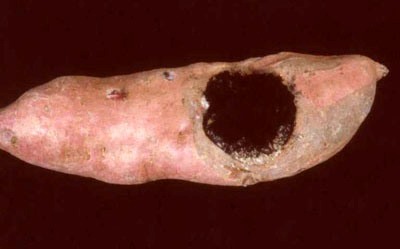|

Internal
and external views of storage roots with Java black rot (J. Lo,
APS).
 Black
sunken lesion on storage root (T. Ames).
|
Diagnostic summary
- on storage
roots: brown to reddish brown, round sunken lesions with solid black
centre surrounded by a soft, pinkish ring of decaying tissue.
- lesions become
hard, sunken and completely blackened.
- infection may
start in one or both ends of fleshy root, entire root dries out and
mummifies. During drying process, black structures emerge through root periderm
and surrounding tissues turn black.
|
Taxonomy
Economic
importance
Geographical
distribution
Symptoms
Morphology
Biology
and ecology
Host
range
Management
References
View full fact sheet
|

